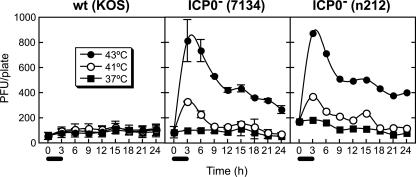FIG. 5.
The heat shock-induced increase in plating efficiency of ICP0− viruses on Vero cell monolayers is transient. Twenty-four-hour-old Vero cell monolayers in 35-mm plates were incubated at 37°C, 41°C, or 43°C for 3 h (from 0 to 3 h on the x axis, as indicated by the bars under the axis) and at 37°C for the remainder of the experiment. At 3-h intervals, replicate monolayers from each treatment group were infected with ∼100 PFU/plate wild-type or ∼20 or ∼100 PFU/plate ICP0− virus. If monolayers infected with ∼100 PFU/plate ICP0− virus resulted in too many plaques to count, those infected with ∼20 PFU were counted instead, and the result was multiplied by 5. Infected cells were incubated at 37°C for 4 days and stained, and plaques were counted. Times shown on the x axis are the numbers of hours following transfer to the elevated temperature. This experiment was performed twice for KOS and 7134 and once for n212. For KOS and 7134, the figure represents the average results for the two experiments and error bars represent the standard deviations.

